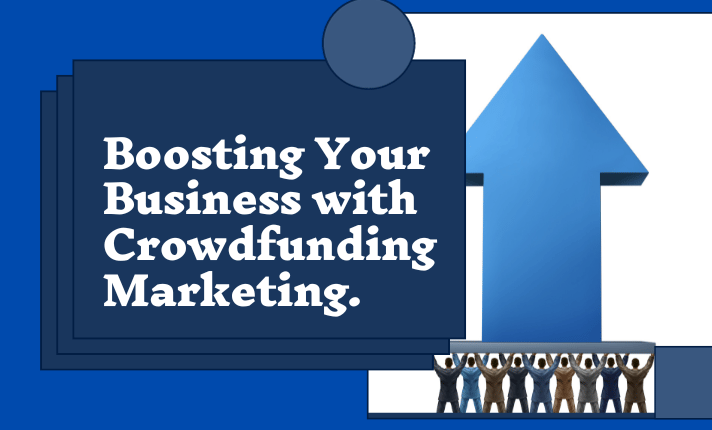Mastering the Art of Crowdfunding | Are you a creative entrepreneur with a fantastic idea you don’t have the money to realize? Have you heard of crowdsourcing but need help using it to your advantage? There’s nowhere else to look! We’ll explore the world of crowdfunding in this blog post and reveal the keys to success. The emergence of platforms such as Kickstarter has made marketing a crucial component of any crowdfunding initiative. But in this cutthroat market, success requires more than a clever marketing plan. We’ll review the essential components of a fruitful crowdsourcing campaign, such as creating a solid support network and establishing attainable objectives. Prepare yourself to become an expert at crowdfunding so you can fulfil your dreams!
Mastering the Art of Crowdfunding | Unmasking Crowdfunding: The Definition and The Basics
Crowdfunding is a contemporary, innovative method of raising capital for an endeavour or project by enticing modest sums of money from many people, usually online. Consider it the digital age equivalent of traditional fundraising techniques but with more democratic potential and a wider reach. The concept is predicated on the strength of teamwork. Thousands or even millions of potential contributors can be reached through crowdfunding, which uses the internet to reach out to them instead of asking for large sums from a select group of investors. Crowdfunding provides a unique chance for small businesses, artists, inventors, and nonprofits to receive support and validation from the general public through money.
However, running a successful crowdfunding campaign involves more than just creating a campaign and waiting for money. It’s a systematic process that calls for marketing, strategy, captivating storytelling, and a strong pitch. It is your responsibility as a creator to persuade potential backers that their money and support would be well spent on your project. Your first step towards a successful campaign will be to grasp these fundamentals of crowdfunding.
Mastering the Art of Crowdfunding | The Four Principal Types of Crowdfunding
It’s essential to educate yourself on the four primary forms of crowdfunding before starting a campaign: debt, equity, rewards, and donations. Usually used by nonprofits or social causes, donation-based crowdfunding involves contributions made by contributors without expecting a return. Popular on websites like Kickstarter, reward-based crowdfunding gives contributors access to experiences, goods, or services in return for their money.
Entrepreneurs, artists, and inventors commonly use this type. On the other hand, peer-to-peer lending, or debt crowdfunding, entails investors lending money in exchange for interest payments and the return on their initial investment. Lastly, equity crowdfunding allows donors to own a portion of the business, typically by purchasing shares. Every variety has unique benefits and works well for various projects. Therefore, it’s critical that you, as the creator, choose the one that best fits your project and the expectations of potential backers.
Additionally, by expanding the campaign’s reach and visibility, working with a crowdfunding marketing agency or applying Kickstarter marketing techniques can help your campaign succeed even more. This becomes especially important when attracting high-value investments or a more significant number of contributors.
Mastering the Art of Crowdfunding | An Overview of the Crowdfunding Process
A project that requires funding is the starting point of the crowdsourcing process. It’s time to create an engaging campaign after clarifying your project and deciding which kind of crowdfunding best meets your requirements. This entails crafting a compelling story for your project, emphasising its unique selling proposition, and establishing a precise yet achievable funding target.
To help potential backers visualise the impact of your project and understand what they stand to gain from supporting it, your campaign page should include images, videos, and other content. Once your campaign has been launched on a crowdfunding platform, it is essential to use various marketing strategies, such as email marketing, public relations, and social media outreach, to spread the word about it. It’s also critical to keep your backers interested throughout the campaign by sending them regular updates and showing appreciation for their support. Recall that creating a community of ardent supporters committed to seeing your project through to completion and sharing your belief in its success is just as crucial to a successful campaign as meeting your funding target.
The Role of Crowdfunding Platforms
Crowdfunding platforms are online markets that connect creators and backers by providing a venue for exciting ideas to connect with possible investors. These websites, including GoFundMe, Indiegogo, and Kickstarter, offer a simple framework for starting and running campaigns.
They provide a range of tools so that creators can interact with backers, track their progress, professionally showcase their work, and give out rewards. These platforms are a central location for backers to learn about and choose from innovative new projects and causes. They offer the comfort of a safe and secure transaction process, progress reports on the project, and direct access to the creators. Though these platforms streamline the crowdfunding process, they also bring in competition.
It becomes difficult to stand out when there are thousands of active projects at any given time. To ensure that your campaign attracts potential backers and generates traffic, you must implement efficient marketing and promotion strategies for Kickstarter. Remember that while the platform serves as the stage, your ability to engage the audience will determine how well your performance goes.
Keys to a Successful Crowdfunding Campaign
Even though every campaign is different, some components are necessary for success. A captivating story is essential to any successful crowdfunding campaign. More is needed to describe your project; you must also explain its significance and potential impact. Bring your story to life with multimedia, such as pictures and videos, to help potential backers better understand your vision. Next, decide on a reasonable funding target supported by thorough planning and budgeting. If you overestimate, you might turn off potential backers; if you underestimate, you might need more money to finish the project.
The rewards you provide are another important factor; they should be eye-catching and commensurate with the backer’s pledge. Use your network to create initial momentum—strong campaigns tend to perform better in the long run. To reach a larger audience, heavily publicise your campaign using digital marketing strategies like email marketing and social media promotion. Lastly, stay in touch with your supporters during the campaign by sending them updates and showing appreciation. To succeed in crowdfunding, remember that creating a community of supporters for your project is just as important as raising money. This is where a Kickstarter marketing agency can help. They can maximise your crowdfunding marketing approach and assist in creating a community that not only contributes funds to your project but also helps it reach a wider audience. This enhances the performance of your ongoing campaign and builds a solid basis for all upcoming crowdfunding initiatives.
The Power and Limitations of Crowdfunding
Accepting the potential of crowdsourcing can lead to previously unimaginable possibilities. It democratises fundraising by removing money-related obstacles and enabling anyone with a great idea to look for funding. It extends your reach, allowing you to establish connections with backers worldwide and validating your project idea immediately. In addition to meeting your financial needs, crowdfunding builds a community of devoted supporters who could become recurring clients and brand ambassadors.
Crowdfunding does, however, have certain restrictions. It can be challenging to stand out on platforms due to the intense competition. It also requires much time, effort, and knowledge in marketing, customer service, and storytelling. It also adds a public component of success or failure that may affect how people view your project. Additionally, there is no assurance that you will raise the money you need, and some platforms have an “all-or-nothing” policy, which means you won’t get paid if your target isn’t met. As a result, it’s critical to approach crowdfunding with a sound plan, reasonable expectations, and a knowledge of its advantages and disadvantages.











